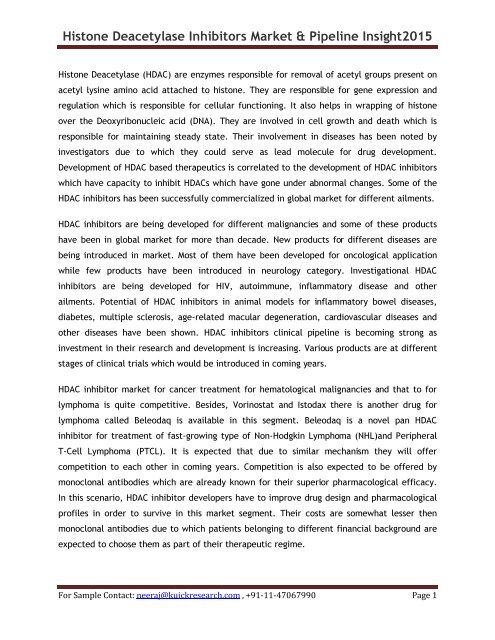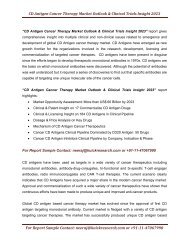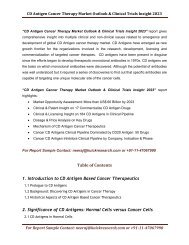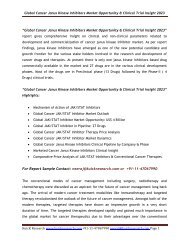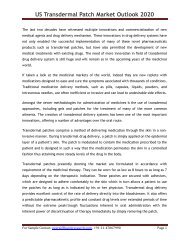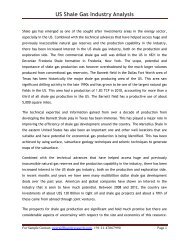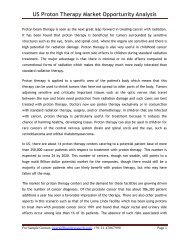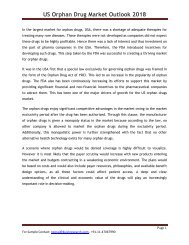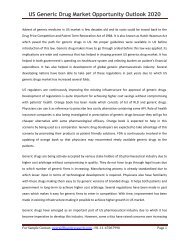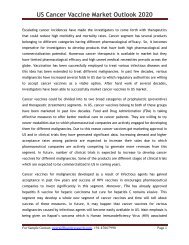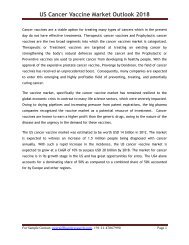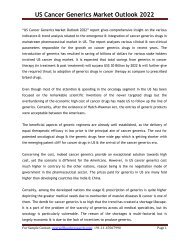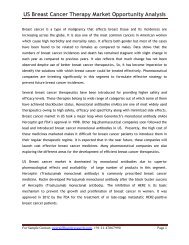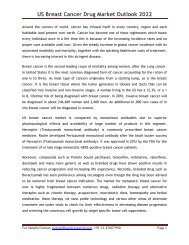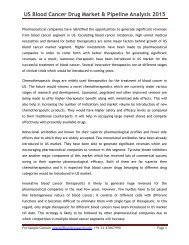Histone Deacetylase Inhibitors Market & Pipeline Insight 2015
\"Histone Deacetylase (HDAC) Inhibitors Market & Pipeline Insight 2015\" Report Highlights: Introduction & Classification Histone Deacetylase (HDAC) Inhibitors Mechanism of Histone Deacetylase (HDAC) Inhibitors Histone Deacetylase (HDAC) Inhibitors Market Dynamics Global Histone Deacetylase (HDAC) Inhibitor Market Outlook Histone Deacetylase (HDAC) Inhibitor Clinical Pipeline by Company, Indication & Phase Histone Deacetylase (HDAC) Inhibitor Clinical Pipeline: 63 Majority of Histone Deacetylase (HDAC) Inhibitor in Preclinical Phase: 35 Marketed Histone Deacetylase (HDAC) Inhibitors: 3 (Beleodaq, Istodax & Zolinza)
\"Histone Deacetylase (HDAC) Inhibitors Market & Pipeline Insight 2015\" Report Highlights:
Introduction & Classification Histone Deacetylase (HDAC) Inhibitors
Mechanism of Histone Deacetylase (HDAC) Inhibitors
Histone Deacetylase (HDAC) Inhibitors Market Dynamics
Global Histone Deacetylase (HDAC) Inhibitor Market Outlook
Histone Deacetylase (HDAC) Inhibitor Clinical Pipeline by Company, Indication & Phase
Histone Deacetylase (HDAC) Inhibitor Clinical Pipeline: 63
Majority of Histone Deacetylase (HDAC) Inhibitor in Preclinical Phase: 35
Marketed Histone Deacetylase (HDAC) Inhibitors: 3 (Beleodaq, Istodax & Zolinza)
You also want an ePaper? Increase the reach of your titles
YUMPU automatically turns print PDFs into web optimized ePapers that Google loves.
<strong>Histone</strong> <strong>Deacetylase</strong> <strong>Inhibitors</strong> <strong>Market</strong> & <strong>Pipeline</strong> <strong>Insight</strong><strong>2015</strong><br />
<strong>Histone</strong> <strong>Deacetylase</strong> (HDAC) are enzymes responsible for removal of acetyl groups present on<br />
acetyl lysine amino acid attached to histone. They are responsible for gene expression and<br />
regulation which is responsible for cellular functioning. It also helps in wrapping of histone<br />
over the Deoxyribonucleic acid (DNA). They are involved in cell growth and death which is<br />
responsible for maintaining steady state. Their involvement in diseases has been noted by<br />
investigators due to which they could serve as lead molecule for drug development.<br />
Development of HDAC based therapeutics is correlated to the development of HDAC inhibitors<br />
which have capacity to inhibit HDACs which have gone under abnormal changes. Some of the<br />
HDAC inhibitors has been successfully commercialized in global market for different ailments.<br />
HDAC inhibitors are being developed for different malignancies and some of these products<br />
have been in global market for more than decade. New products for different diseases are<br />
being introduced in market. Most of them have been developed for oncological application<br />
while few products have been introduced in neurology category. Investigational HDAC<br />
inhibitors are being developed for HIV, autoimmune, inflammatory disease and other<br />
ailments. Potential of HDAC inhibitors in animal models for inflammatory bowel diseases,<br />
diabetes, multiple sclerosis, age-related macular degeneration, cardiovascular diseases and<br />
other diseases have been shown. HDAC inhibitors clinical pipeline is becoming strong as<br />
investment in their research and development is increasing. Various products are at different<br />
stages of clinical trials which would be introduced in coming years.<br />
HDAC inhibitor market for cancer treatment for hematological malignancies and that to for<br />
lymphoma is quite competitive. Besides, Vorinostat and Istodax there is another drug for<br />
lymphoma called Beleodaq is available in this segment. Beleodaq is a novel pan HDAC<br />
inhibitor for treatment of fast-growing type of Non-Hodgkin Lymphoma (NHL)and Peripheral<br />
T-Cell Lymphoma (PTCL). It is expected that due to similar mechanism they will offer<br />
competition to each other in coming years. Competition is also expected to be offered by<br />
monoclonal antibodies which are already known for their superior pharmacological efficacy.<br />
In this scenario, HDAC inhibitor developers have to improve drug design and pharmacological<br />
profiles in order to survive in this market segment. Their costs are somewhat lesser then<br />
monoclonal antibodies due to which patients belonging to different financial background are<br />
expected to choose them as part of their therapeutic regime.<br />
For Sample Contact: neeraj@kuickresearch.com , +91-11-47067990 Page 1
<strong>Histone</strong> <strong>Deacetylase</strong> <strong>Inhibitors</strong> <strong>Market</strong> & <strong>Pipeline</strong> <strong>Insight</strong><strong>2015</strong><br />
Novel HDAC inhibitors are also being discovered by investigators but their pharmacological<br />
and commercialization potential remains elusive. Some of them are already established in<br />
global market and others are being revisited for their therapeutics efficacy in other disease<br />
Segments.<br />
Hydroxamates are one of the largest segment of HDAC inhibitors which have made their niche<br />
in cancer market segment. Other categories are also being developed for different ailments<br />
due to their role in blocking different HDAC members. It could be observed that they belong<br />
to different biological groups like aliphatic acids and cyclopeptides. On the other hand,<br />
synthetic derivatives are also available which could be easily modified by chemical processes.<br />
This fact shows that investigators have plethora of choices that will help them in<br />
development of suitable pharmaceutical product having high commercialization potential.<br />
However, lots of work is required in this segment for occupying major market shares and<br />
competing with previously available therapeutics.<br />
"<strong>Histone</strong> <strong>Deacetylase</strong> (HDAC) <strong>Inhibitors</strong> <strong>Market</strong> & <strong>Pipeline</strong> <strong>Insight</strong> <strong>2015</strong>"<br />
Report Highlights:<br />
• Introduction & Classification <strong>Histone</strong> <strong>Deacetylase</strong> (HDAC) <strong>Inhibitors</strong><br />
• Mechanism of <strong>Histone</strong> <strong>Deacetylase</strong> (HDAC) <strong>Inhibitors</strong><br />
• <strong>Histone</strong> <strong>Deacetylase</strong> (HDAC) <strong>Inhibitors</strong> <strong>Market</strong> Dynamics<br />
• Global <strong>Histone</strong> <strong>Deacetylase</strong> (HDAC) Inhibitor <strong>Market</strong> Outlook<br />
• <strong>Histone</strong> <strong>Deacetylase</strong> (HDAC) Inhibitor Clinical <strong>Pipeline</strong> by Company, Indication & Phase<br />
• <strong>Histone</strong> <strong>Deacetylase</strong> (HDAC) Inhibitor Clinical <strong>Pipeline</strong>: 63<br />
• Majority of <strong>Histone</strong> <strong>Deacetylase</strong> (HDAC) Inhibitor in Preclinical Phase: 35<br />
• <strong>Market</strong>ed <strong>Histone</strong> <strong>Deacetylase</strong> (HDAC) <strong>Inhibitors</strong>: 3 (Beleodaq, Istodax & Zolinza)<br />
For Report Sample Contact: neeraj@kuickresearch.com<br />
For Sample Contact: neeraj@kuickresearch.com , +91-11-47067990 Page 2
<strong>Histone</strong> <strong>Deacetylase</strong> <strong>Inhibitors</strong> <strong>Market</strong> & <strong>Pipeline</strong> <strong>Insight</strong><strong>2015</strong><br />
Table of Contents<br />
1. Introduction to <strong>Histone</strong> <strong>Deacetylase</strong> (HDAC) <strong>Inhibitors</strong><br />
2. Classification of <strong>Histone</strong> <strong>Deacetylase</strong> (HDAC)<br />
2.1 Class I HDAC<br />
2.2 Class IIa HDAC<br />
2.3 Class IIb HDAC<br />
2.4 Class IV HDAC<br />
3. Classification of <strong>Histone</strong> <strong>Deacetylase</strong> (HDAC) <strong>Inhibitors</strong><br />
3.1 Hydroxamates<br />
3.2 Cyclic Peptides<br />
3.3 Aliphatic Acids<br />
3.4 Benzamides<br />
4. Mechanism of <strong>Histone</strong> <strong>Deacetylase</strong> (HDAC) <strong>Inhibitors</strong><br />
5. Global <strong>Histone</strong> <strong>Deacetylase</strong> (HDAC) Inhibitor <strong>Market</strong> Outlook<br />
5.1 Curent <strong>Market</strong> Scenario<br />
5.2 <strong>Histone</strong> <strong>Deacetylase</strong> (HDAC) <strong>Pipeline</strong> Overview<br />
6. <strong>Histone</strong> <strong>Deacetylase</strong> (HDAC) <strong>Inhibitors</strong> <strong>Market</strong> Dynamics<br />
6.1 Favorable <strong>Market</strong> Parameters<br />
6.2 Commercialization Challenges<br />
7. <strong>Histone</strong> <strong>Deacetylase</strong> (HDAC) <strong>Inhibitors</strong> Future Prospects<br />
For Sample Contact: neeraj@kuickresearch.com , +91-11-47067990 Page 3
<strong>Histone</strong> <strong>Deacetylase</strong> <strong>Inhibitors</strong> <strong>Market</strong> & <strong>Pipeline</strong> <strong>Insight</strong><strong>2015</strong><br />
8. <strong>Histone</strong> <strong>Deacetylase</strong> (HDAC) Inhibitor Clinical <strong>Pipeline</strong> by Company, Indication &<br />
Phase<br />
8.1 Research<br />
8.2 Preclinical<br />
8.3 Phase-I<br />
8.4 Phase-I/II<br />
8.5 Phase-II<br />
8.6 Phase-III<br />
8.7 Registered<br />
9. <strong>Market</strong>ed <strong>Histone</strong> <strong>Deacetylase</strong> (HDAC) Inhibitor Clinical <strong>Insight</strong> by Company &<br />
Indication<br />
9.1 Belinostat (Beleodaq)<br />
9.2 Romidepsin (Istodax)<br />
9.3 Vorinostat (Zolinza)<br />
10. Discontinued & Suspended <strong>Histone</strong> <strong>Deacetylase</strong> (HDAC) Inhibitor Clinical <strong>Insight</strong><br />
10.1 No Development Reported<br />
10.2 Discontinued<br />
10.3 Suspended<br />
11. Competitive Landscape<br />
11.1 4SC<br />
11.2 Acetylon Pharmaceuticals<br />
11.3 Astellas Pharma<br />
11.4 Celleron Therapeutics<br />
11.5 Chipscreen Biosciences<br />
For Sample Contact: neeraj@kuickresearch.com , +91-11-47067990 Page 4
<strong>Histone</strong> <strong>Deacetylase</strong> <strong>Inhibitors</strong> <strong>Market</strong> & <strong>Pipeline</strong> <strong>Insight</strong><strong>2015</strong><br />
11.6 Chroma Therapeutics<br />
11.7 Chong Kun Dang Pharmaceutical<br />
11.8 CrystalGenomics<br />
11.9 Curis<br />
11.10 Digna Biotech<br />
11.11 Evgen<br />
11.12 Johnson & Johnson Pharmaceutical Research and Development<br />
11.13 Italfarmaco<br />
11.14 MEI Pharma<br />
11.15 Mirati Therapeutics<br />
11.16 Novartis<br />
11.17 Onxeo<br />
11.18 Orchid Chemicals and Pharmaceuticals<br />
11.19 Pharmacyclics<br />
11.20 Repligen<br />
11.21 TetraLogic Pharmaceuticals<br />
For Sample Contact: neeraj@kuickresearch.com , +91-11-47067990 Page 5
<strong>Histone</strong> <strong>Deacetylase</strong> <strong>Inhibitors</strong> <strong>Market</strong> & <strong>Pipeline</strong> <strong>Insight</strong><strong>2015</strong><br />
List of Figures<br />
Figure 1-1: Properties of HDAC<br />
Figure 1-2: Therapeutic Utility of HDAC <strong>Inhibitors</strong><br />
Figure 1-3: Benefits of HDAC <strong>Inhibitors</strong><br />
Figure 1-4: Limitation of HDAC <strong>Inhibitors</strong><br />
Figure 2-1: Classification of HDAC<br />
Figure 3-1: Classification of HDAC <strong>Inhibitors</strong><br />
Figure 4-1: Mechanism of Vorinostat<br />
Figure 4-2: Mechanism of Panobinostat<br />
Figure 4-3: Mechanism of Resminostat<br />
Figure 4-4: Mechanism of Entinostat<br />
Figure 5-1: <strong>Histone</strong> <strong>Deacetylase</strong> (HDAC) <strong>Pipeline</strong> by Phase (%), <strong>2015</strong><br />
Figure 5-2: <strong>Histone</strong> <strong>Deacetylase</strong> (HDAC) <strong>Pipeline</strong> by Phase (Number), <strong>2015</strong><br />
Figure 5-3: Discontinued <strong>Histone</strong> <strong>Deacetylase</strong> (HDAC) <strong>Pipeline</strong> by Phase (%), <strong>2015</strong><br />
Figure 5-4: Discontinued <strong>Histone</strong> <strong>Deacetylase</strong> (HDAC) <strong>Pipeline</strong> by Phase (Number), <strong>2015</strong><br />
Figure 6-1: HDAC <strong>Inhibitors</strong> <strong>Market</strong> Favorable Parameters<br />
Figure 6-2: HDAC <strong>Market</strong>Commercialization Challenges<br />
Figure 11-1: 4SC Clinical <strong>Pipeline</strong><br />
Figure 11-2: Celleron Therapeutics Clinical <strong>Pipeline</strong><br />
Figure 11-3: Curis Clinical <strong>Pipeline</strong><br />
Figure 11-4: DIGNA Biotech Clinical <strong>Pipeline</strong><br />
Figure 11-5: Onxeo Clinical <strong>Pipeline</strong><br />
For Sample Contact: neeraj@kuickresearch.com , +91-11-47067990 Page 6
<strong>Histone</strong> <strong>Deacetylase</strong> <strong>Inhibitors</strong> <strong>Market</strong> & <strong>Pipeline</strong> <strong>Insight</strong><strong>2015</strong><br />
Figure 11-6: TetraLogic Pharmaceuticals Clinical <strong>Pipeline</strong><br />
List of Tables<br />
Table 1-1: Few Important HDACi under Development for Different Indications<br />
Table 3-1: HDAC <strong>Inhibitors</strong> Belonging to Different Classes<br />
Table 4-1: FDA Approved HDACi for Lymphoma<br />
For Report Sample Contact: neeraj@kuickresearch.com<br />
For Sample Contact: neeraj@kuickresearch.com , +91-11-47067990 Page 7


